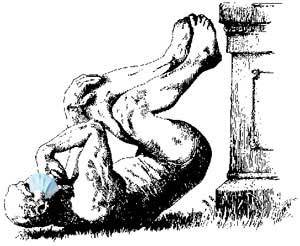Marc Abrahams's Blog, page 116
June 1, 2020
The effects of juiciness in an action RPG [new study]
“A juicy game element will bounce and wiggle and squirt and make a little noise when you touch it.”
When it comes to ‘Juiciness’ in Role Playing (Computer) Games, too much, or too little, it seems, can be non-ideal. Professor Dominic Kao and colleagues at the Virtual Futures Lab, Purdue University, US, have experimentally investigated such things – noting that :
“This is, to the best of our knowledge, the largest study to date on juiciness.”
“We created four versions of the same identical action RPG game*, but with differing levels of visual/audio effects: No Juiciness, Medium Juiciness, High Juiciness, and Extreme Juiciness. Overall, both Medium Juiciness and High Juiciness outperform No Juiciness and Extreme Juiciness across all measures.”
See: The effects of juiciness in an action RPG in Entertainment Computing, Volume 34, May 2020. (Also available in PDF format*)
* Note: The paper sports a number of examples of a linguistic construction called RAS syndrome* ( i.e. Redundant Acronym Syndrome, Syndrome ) with three references to “RPG game”* (i.e. ‘Role Playing Game, Game’).
Research research by Martin Gardiner

May 30, 2020
Pocket-Sized #1011: “Judging Aggressive Roaring”
Judging Aggressive Roaring
In this Pocket-Sized episode #1011, Marc Abrahams shows an unfamiliar research study to Jean Berko Gleason. Dramatic readings and reactions ensue.
The research mentioned in this episode is featured in the special Psychology issue (vol. 26, #1) of the Annals of Improbable Research magazine.

Remember, our Patreon donors, on most levels, get access to each podcast episode before it is made public.
1. Jean Berko Gleason encounters:
“Human Listeners Can Accurately Judge Strength and Height Relative to Self from Aggressive Roars and Speech,” Jordan Raine, Katarzyna Pisanski, Anna Oleszkiewicz, Julia Simner, and David Reby, iScience, vol. 4, 2018, pp. 273–280.
Seth Gliksman, Production Assistant
Available on Spotify, Apple Podcasts, Overcast, Google Podcasts, AntennaPod, BeyondPod and elsewhere!

May 29, 2020
“Try Hard to Be a Baby” [Animal]—a nifty biology book for kids
“Hard, hard to be a baby—Baby animals like you’ve never seen them” is more or less the English translation of the French title of Brooke Barker’s book Dur, dur d’être un bébé—Les bébés animaux comme vous ne les avez jamais vus. The book is full of facts and drawings about many kinds and sizes of baby animals. On a technical level, one could accurately say that the book is full of paper and ink, though not in its ebook version.
Barker also draws and writes the blog Sad Animal Facts, in which the words are mostly in English, though with a generous helping of words presumably from a variety of animal languages.
Barker also drew and wrote the book La tortue qui respirait par les fesses [“The turtle that breathes through its butt”].

May 27, 2020
Podcast Episode #211: “Richard Wassersug”
Richard Wassersug and The Tastiness (or Palatability) of Tadpoles, Motion Sickness in Amphibians, Frog Copulation in Microgravity, Reactions of a Snake and Turtle, Ecstatic About Eunuchs, Eggs All Sorts, Bird, Flesh, Every Kind, The Ups and Downs of Cows, and the Birth of Murphy’s Law.
In episode #211, Marc Abrahams shows some unfamiliar research studies to Jean Berko Gleason and Melissa Franklin. Dramatic readings and reactions ensue.
Remember, our Patreon donors, on most levels, get access to each podcast episode before it is made public.
1. Marc Abrahams encounters:
“On the Comparative Palatability of Some Dry-Season Tadpoles from Costa Rica,” Richard Wassersug, The American Midland Naturalist, vol. 86, no. 1, July 1971, pp. 101-9
2. Melissa Franklin encounters:
“The Behavioral Reactions of a Snake and a Turtle to Abrupt Decreases in Gravity,” R. Wassersug and A. Izumi-Kurotani, Zoological Science, vol. 10, no. 3., June 1, 1993, p. 505.
3. Jean Berko Gleason encounters:
“Motion Sickness in Amphibians,” Richard J. Wassersug, Akemi Izumi-Kurotani, Masamichi , and Tomio Naitoh, Behavioral and Neural Biology, vol. 60, 1993, pp. 42-51.
4.Melissa Franklin encounters:
“Amphibian Amplexus in Microgravity,” Tomio Naitoh, Masamichi Yamashita, Akemi Izumi-Kurotani, Shigefumi Yokota, and Richard J. Wassersug, ” Zoological Science, vol. 12, no. 1, 1995, pp. 113-116.
5. Marc Abrahams encounters:
Roberts, Lesley F., Michelle A. Brett, Thomas W. Johnson, and Richard J. Wassersug (2007). ‘A Passion for Castration: Characterizing Men Who Are Fascinated with Castration, but Have Not Been Castrated.’ Journal of Sexual Medicine 5 (7): 1669–80.
Brett, Michelle A., Lesley F. Roberts, Thomas W. Johnson, and Richrard J. Wassersug (2007). ‘Eunuchs in Contemporary Society: Expectations, Consequences and Adjustments to Castration. Part II.’ Journal of Sexual Medicine 4 (4): 946–55.
6. Marc Abrahams encounters:
Cott, Hugh B. (1945). ‘The Edibility of Birds.’ Nature 156 (3973): 736–37.
–– (1947). ‘The Edibility of Birds – Illustrated by 5 Years Experiments and Observations (1941–1946) on the Food Preferences of the Hornet, Cat and Man – and Considered with Special Reference to the Theories of Adaptive Coloration.’ Proceedings of the Zoological Society of London 116 (3-4): 371–524.
–– (1948). ‘Edibility of the Eggs of Birds.’ Nature 161 (4079): 8–11.
–– (1951). ‘The Palatability of the Eggs of Birds – Illustrated by Experiments on the Food Preferences of the Hedgehog (erinaceus-europaeus).’ Proceedings of the Zoological Society of London 121 (1): 1–40.
–– (1952). ‘The Palatability of the Eggs of Birds: Illustrated by Three Seasons’ Experiments (1947, 1948 and 1950) on the Food Preferences of the Rat (Rattus norvegicus); and with Special Reference to the Protective Adaptations of Eggs Considered in Relation to Vulnerability.’ Proceedings of the Zoological Society of London 122 (1): 1–54.
–– (1953). ‘The Palatability of the Eggs of Birds – Illustrated by Experiments on the Food Preferences of the Ferret (Putorius-Furo) and Cat (Felis-Catus) – With Notes on Other Egg-Eating Carnivora.’ Proceedings of the Zoological Society of London 123 (1): 123–41.
–– (1954). ‘The Palatability of Eggs and Birds: Mainly Based upon Observations of an Egg Panel.’ Proceedings of the Zoological Society of London 124 (2): 335–463.
7. Marc Abrahams encounters:
Tolkamp, Bert J., Marie J. Haskell, Fritha M. Langford, David J. Roberts and Colin A. Morgan (2010). ‘Are Cows More Likely to Lie Down the Longer They Stand?’ Applied Animal Behaviour Science 124, (1-2): 1–10.
Osterman, Sara, and Ingrid Redbo (2001). ‘Effects of Milking Frequency on Lying Down and Getting Up Behaviour of Dairy Cows.’ Applied Animal Behaviour Science 70 (3): 167–76.
8. Marc Abrahams encounters:
For a detailed history of the birth and subsequent history of Murphy’s Law — and the heroic role played by John Paul Stapp — see “The Fastest Man on Earth,” by Nick T. Spark, Annals of Improbable Research, volume 9, number 5, September/October 2003. Much of the account here is based on Nick Spark’s research, which he eventually expanded into a book called A History of Murphy’s Law. Some additional information is also available from the museum at Edwards Air Force Base.
Bruce Petschek, Audio Engineer
Jon Shedler, Audio Engineer
Seth Gliksman, Production Assistant
Available on Spotify, Apple Podcasts, Overcast, Google Podcasts, AntennaPod, BeyondPod and elsewhere!

May 25, 2020
Insect (names) in Fireworks [study]
Dr. Joe Coelho, who is Professor of Biology at Quincy University, Illinois, US, is the author of ‘Insects In Fireworks’ a paper published in Ethnoentomology: an Open Journal of Ethnoentomology and Cultural Entomology, 2: 20–29.
To clarify, the paper is not about the use of insects as ingredients in firework mixtures, but rather the use of their names in firework branding.
“Fireworks with entomological names were observed in order to examine how arthropods were represented. Hymenoptera were the most commonly occurring group, followed by Lepidoptera and Arachnida. Fountains were the most common type of entomological firework, followed by aerial spinners. The most frequent noise associated with insect fireworks was the crackle, followed by the hummer.”
The paper can be read in full here :
The professor maintains a YouTube channel showing a collection of videos of entomological fireworks for a study in cultural entomology.
Note: The paper (and the videos) also feature some spiders which, it may be remembered, are not insects, but non-insect arthropods.
Research research by Martin Gardiner

May 23, 2020
Pocket-Sized #1010: “Hot Potato Voice”
Hot Potato Voice
In this Pocket-Sized episode #1010, Marc Abrahams shows some unfamiliar research studies to Dany Adams. Dramatic readings and reactions ensue.
Remember, our Patreon donors, on most levels, get access to each podcast episode before it is made public.
1. Dany Adams encounters:
“‘Hot Potato Voice’ in Peritonsillitis: A Misnomer,” Mahmood F. Bhutta, George A. Worley and Meredydd L. Harries, Journal of Voice, vol. 20, no. 4, December 2006, pp. 616-622.
Seth Gliksman, Production Assistant
Available on Spotify, Apple Podcasts, Overcast, Google Podcasts, AntennaPod, BeyondPod and elsewhere!

May 22, 2020
How to write a hard-to-resist science headline: Quantum, Coffee
Trinity College Dublin produced a press release, on January 31, 2020, with this headline: “Supercomputers help link quantum entanglement to cold coffee“.
 The press release is meant to draw attention to a research paper by Marlon Brenes, Silvia Pappalardi [pictured here], John Goold, and Alessandro Silva.
The press release is meant to draw attention to a research paper by Marlon Brenes, Silvia Pappalardi [pictured here], John Goold, and Alessandro Silva.
The paper is titled “Multipartite Entanglement Structure in the Eigenstate Thermalization Hypothesis,” and published in the journal Physical Review Letters (2020; 124, 4).
The paper itself does not mention coffee.
UPDATE (May 22): Investigator Mason Porter writes: We’ve got the coffee (well, at least the caffeine) covered: “Spatial Applications of Topological Data Analysis: Cities, Snowflakes, Random Structures, and Spiders Spinning Under the Influence“

May 20, 2020
Pocket-Sized #1009: “Barefoot Running”
Barefoot Running
In this Pocket-Sized episode #1009, Marc Abrahams shows some unfamiliar research studies to Jean Berko Gleason. Dramatic readings and reactions ensue.
The research mentioned in this episode is featured in the special Psychology issue (vol. 26, #1) of the Annals of Improbable Research magazine.

Remember, our Patreon donors, on most levels, get access to each podcast episode before it is made public.
1. Jean Berko Gleason encounters:
“An Exploratory Study Investigating the Effects of Barefoot Running on Working Memory,” Ross G. Alloway, Tracy Packiam Alloway, Peter M. Magyari, and Shelley Floyd, Perceptual and Motor Skills, vol. 122, no. 2, 2016, pp. 432-443.
Seth Gliksman, Production Assistant
Available on Spotify, Apple Podcasts, Overcast, Google Podcasts, AntennaPod, BeyondPod and elsewhere!

A rather different Ig Nobel Prize ceremony this (the 30th!) year
The 30th First Annual Ig Nobel Prize ceremony will happen a little differently than its 29 predecessors, because of the COVID-19 pandemic.
Here’s the general plan.

May 19, 2020
A Neighborhood Association with Personality
In some neighborhoods, people belong to a neighborhood association. One of the least-publicized is The Association of Perceived Neighborhood Safety and Inequality with Personality.

Marc Abrahams's Blog
- Marc Abrahams's profile
- 14 followers







